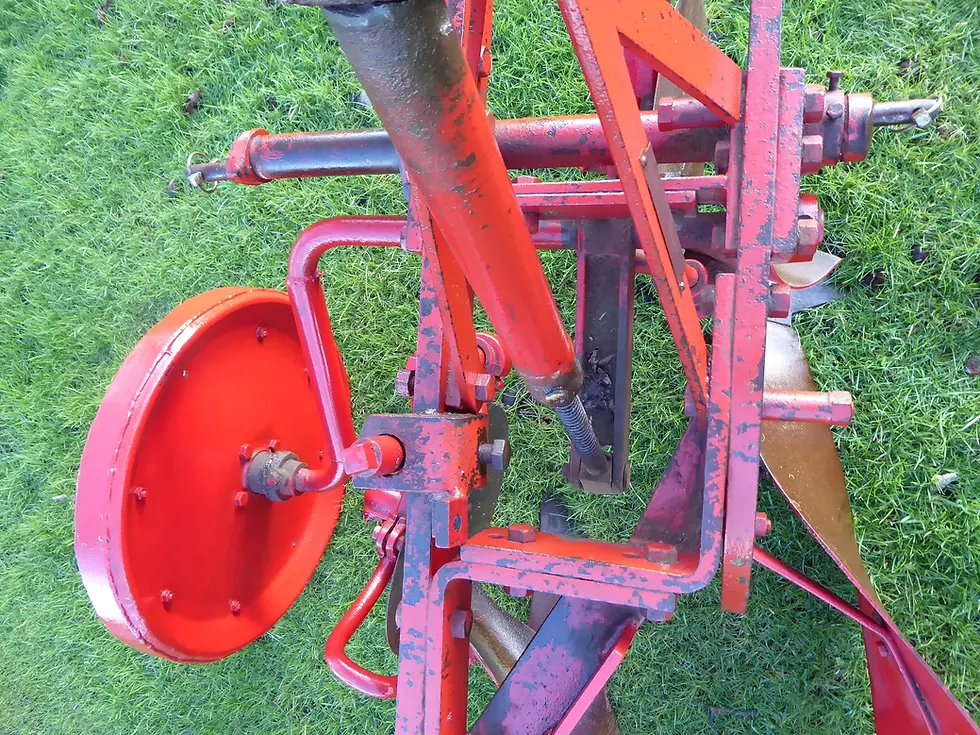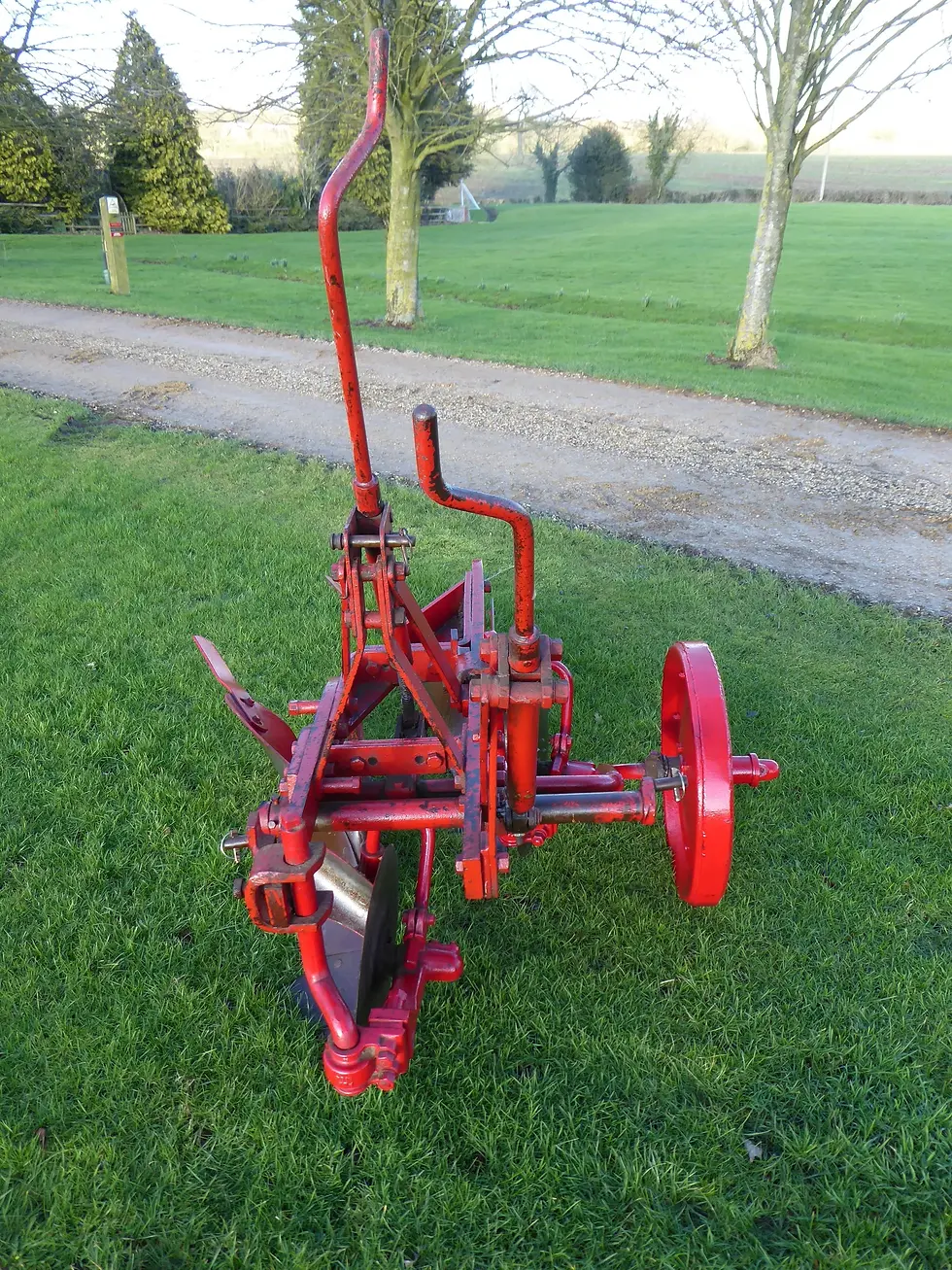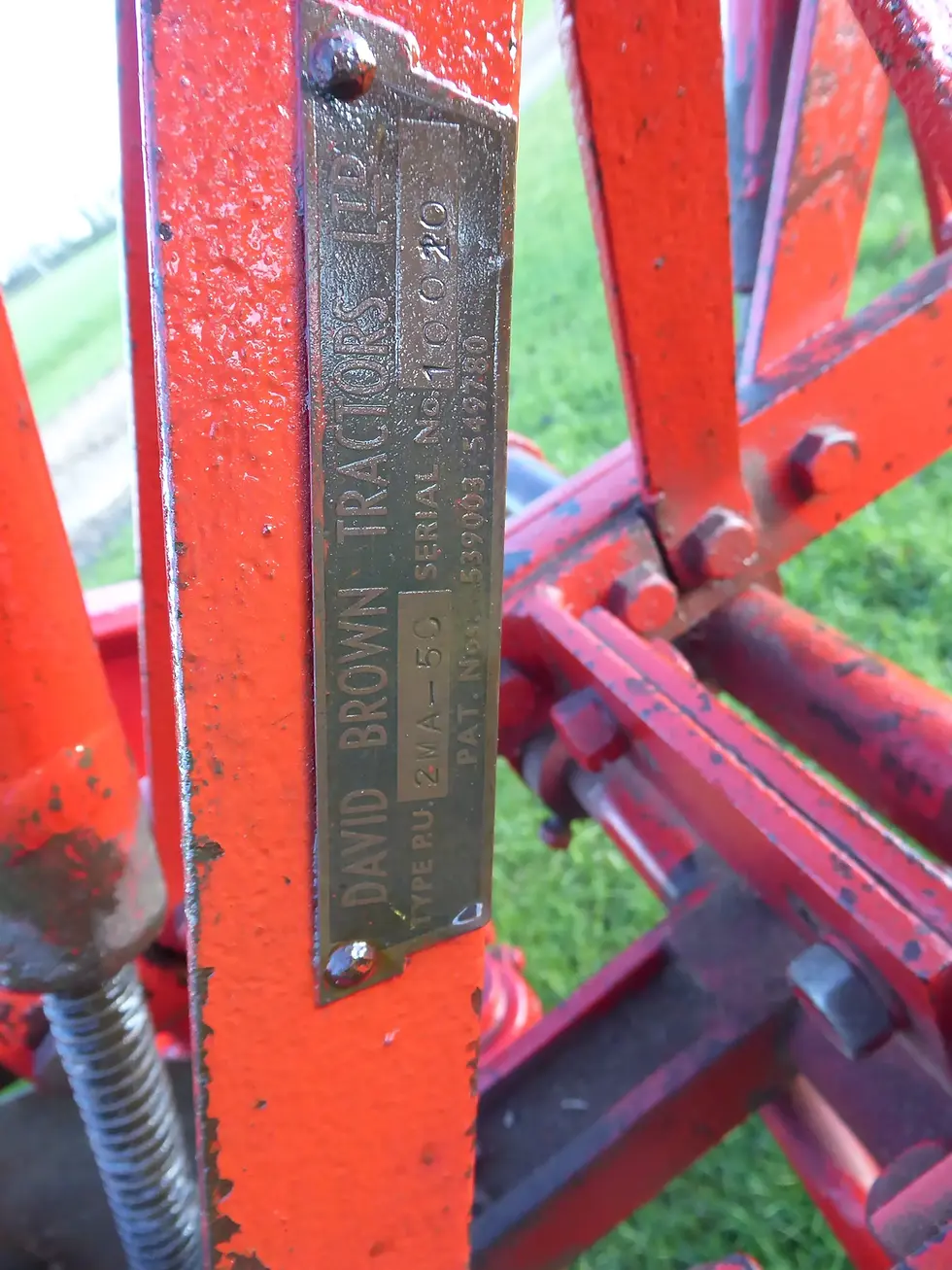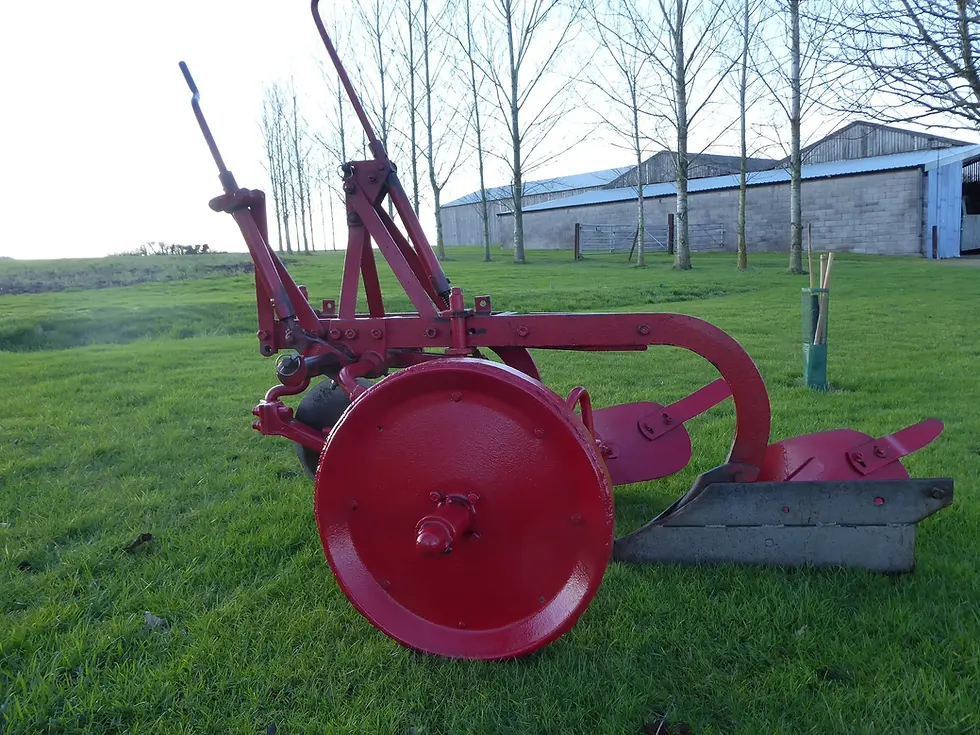Ploughs
This section offers background information on the range of ploughs produced by David Brown to complement their tractors. The following details have been kindly provided by DBTC member “Powerrabbit”, to whom we are very grateful for this valuable contribution.
Please note, this section is currently a work in progress, and we aim to add further information, particularly photographs, as they become available.
Plough Designation and Serial Numbers
A brass plate, usually fixed to the headstock or frame of the plough, displays key identification details. This includes the designation (how the plough is configured), the various types of bodies, coulters, and components used, as well as the serial number.
Designation Code Breakdown
The first letters identify the type or series of plough, such as:
PU, BE, BH, C, CM, CW, CMR, CWR, DM
(Note: For the 'C' type, “W” indicates Wide, and “R” stands for Reversible.)
The next series of letters and numbers explain the construction and components of the plough:
-
2, 3, 4 – Number of furrows
-
M – Medium frame
-
1 – Rigid beam
-
2 – Trip beam
-
3 – Category 1 linkage
-
4 – Category 2 linkage
-
5 – Steel land wheel
-
6 – Rubber-tyred wheel
-
9 – Plain disc coulter, non-tilting
-
10 – Plain disc coulter, tilting
-
11 – Cut-away (scalloped) disc, non-tilting
-
12 – Cut-away disc, tilting
-
19 – Knife coulter
-
17 – Skimmers for non-tilting coulter
-
18 – Skimmers for tilting coulter
-
20 – Heavy-duty standing skimmer
-
21 – Standard standing skimmer

Plough Bodies
-
11 – General Purpose
-
12 – Semi-digger
-
13 – Deep-digger
-
14 – Universal
-
15 – Ley
-
16 – Continental
-
18 – Semi-digger with Dandy bar point
-
19 – Uruguayan
Shares
-
S – Steel
-
C – Cast Iron
-
G – Spheroidal Graphite
Serial Numbers
The serial number, found at the end of the plate, represents the specific build number of the plough. All David Brown plough serial numbers begin with 10. The numbers following this prefix indicate the individual build number.
Plough Series
PU (PRINCIPLE UNIT)
The earliest David Brown ploughs were known as ‘Principle Unit’ or PU ploughs. Production began around 1938, with the initial models being trailed ploughs available in 2- or 3-furrow configurations, equipped with either 8- or 10-inch general-purpose bodies. These ploughs featured a spoked iron land/depth wheel.
When hydraulic ‘power lift’ became available for the VAK1 tractor, the same PU ploughs were adapted accordingly. They were fitted with an adjustable cross-shaft operated by a linkage from the left lift arm of the tractor. This mechanism included a lug on the cross-shaft to control furrow width. Early hydraulic PU ploughs retained the spoked land wheel, but later models could be specified with a pressed steel wheel or an optional rubber-tyred version.
There were five models in the PU series:
-
PU1: A 10-inch general-purpose plough, adjustable to 11 and 12 inches, available in a 2-furrow configuration.
-
PU2: A 12-inch semi-digger, adjustable to 10 or 11 inches.
-
PU3: A single-furrow deep-digger plough with a 16-inch furrow.
-
PU4: A 3-furrow general-purpose plough with 10-inch furrows, adjustable to 8 and 9 inches.
-
PU5: A 2-furrow 10-inch plough, also adjustable to 8 and 9 inches.
All PU ploughs were fitted as standard with 15-inch coulters. A range of share options was available to suit various soil types and conditions. Longer mouldboards for ley (grassland or turf) work were also offered as optional equipment.
Production of the PU plough series continued until around 1950–51, when they were replaced by the 'A' series.

.webp)
.webp)
.webp)
.webp)
.webp)


A big Thank you to Graham Hollingshead for the photos!
-
A SERIES
The A series ploughs were largely similar to the earlier PU models, but featured a key improvement: an adjusting handle mounted directly on the plough frame and connected to the cross-shaft. This replaced the previous link adjustment system on the tractor’s lift arm.
All A series ploughs were 3-furrow models with 10-inch bodies, adjustable to 11 inches. They offered the same range of shares and mouldboard options as the PU series, allowing for versatility across different soil types and conditions.
The A series remained in production until around 1958–59, when they were succeeded by the B series. Notably, an A-type PU plough was specifically designed for use with the Cropmaster rather than the earlier VAK model, with production starting in 1948.

B SERIES
The first B series ploughs featured an open-frame design with angled crossbars between the beams. The headstock was made from plate steel and reinforced with a U-channel strut running from the top rear of the plates down to the centre of the plough beams, replacing the earlier bar struts. This model, known as the ‘BH’ plough, was supplied with 12-inch bodies but could be adjusted to 8 or 10 inches. A range of options was available, including various shares, coulters, land wheels, and mouldboards to suit different soil conditions.
Introduced around the same time was the next model in the series—the ‘BE’ plough.


BE SERIES
This plough retained the same headstock design as the BH model but featured a solid steel plate filling the main frame, rather than the open-frame layout. It was supplied with 12-inch furrows as standard but could be adjusted to 10 or 14 inches and was available in two- or three-furrow configurations. Following this model, the next range introduced was the ‘C’ type ploughs.
C SERIES
The ‘C’ type plough marked a significant departure from earlier designs, with a much stronger steel plate main frame. Introduced around 1961 and produced until 1971, these ploughs incorporated advanced features such as standing leg skimmers, sprung coulter arms, and scalloped disc coulters. In 1971, Ransomes SCN bodies were adopted.
A wide range of optional fittings was available, and many components from previous plough series were used in various combinations. The C type came in two versions: the CM (medium frame) and the CW (wide frame), both available in three-furrow configurations. The medium frame was adjustable from 12 to 14 inches, while the wide frame offered adjustment from 12 to 16 inches.
Spring trip beam versions were also produced, along with two reversible models: the CMR2 and the CW2R—the latter being a wide-frame two-furrow plough. Early reversible models used a manually operated lever with a counterweight for turnover, while later versions featured hydraulic operation.



D SERIES
Another lesser-known plough introduced around 1968 was the ‘D’ type, designated as the DM. While detailed information is limited, it’s understood that the ‘M’ denotes a medium frame, and the ‘D’ refers to an extra-narrow beam—similar in design to the C type but significantly narrower. It is believed that the DM plough was specifically developed for use with the 770 and 780 Selectamatic tractors.

Disc Ploughs
More info to come...

COMPETITION PLOUGHS
David Brown also built specialist ‘Competition’ ploughs, produced to special order rather than for general commercial sale. These ploughs featured a frame similar to the BE type but were fitted with unique mouldboards, offering a profile somewhere between general-purpose and ley types.
The cross-shaft was extended and fully adjustable for furrow width, as was the land wheel. Frogs and mouldboards could be adjusted laterally and vertically to fine-tune the pitch. A series of block plates mounted on the side of the frame allowed precise adjustment of furrow width by inserting them between the frame and beams.
The coulters were both tilting and laterally adjustable, allowing them to be positioned closer to or further from the share point. Interchangeable screw-in pins were also provided on the top of the frame, allowing quick conversion between Category 1 and Category 2 linkage.
